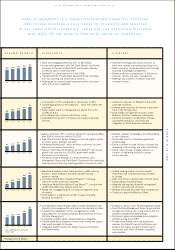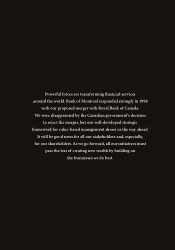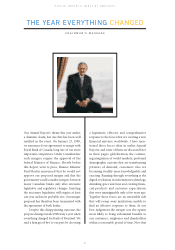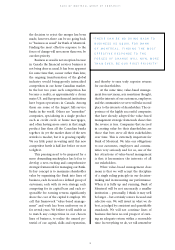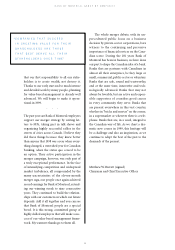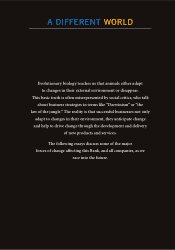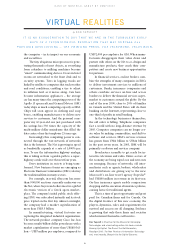Bank of Montreal 1998 Annual Report Download - page 14
Download and view the complete annual report
Please find page 14 of the 1998 Bank of Montreal annual report below. You can navigate through the pages in the report by either clicking on the pages listed below, or by using the keyword search tool below to find specific information within the annual report.
10
BANK OF MONTREAL GROUP OF COMPANIES
that at the local department store downtown,
let’s have a quick coffee in the cafeteria before
the store closes at 6 pm. Welcome to 1969. A
lit
tle over one generation ago, that’s exactly how
many Canadians shopped.
Today, we’d probably drive to the clothing
warehouse store in the factory outlet mall, then
to the power centre in the once-empty field to
compare appliances at the big box electronics
retailer, then motor over to the 24-hour super-
market for the shampoo, log onto the Internet
to order the book and end our evening with a
mocha latte at a premium coffee shop. Welcome
to 1999.
Today’s consumers are more demanding,
and frequently place more value on convenience
and saving time than they do on price. Recre-
ational shopping has all but disappeared, replaced
by destination shopping. Retailers are striving
to make it easier and more convenient for time-
pressed consumers to find what they want and
purchase it quickly. With power centres and big
box stores, convenience means having lots of
selection and great prices in one big location, with
stores open seven days a week and, increasingly,
24 hours a day.
Today, category killers – large stores special-
izing in a fairly narrow range of goods – dominate
the retail landscape. They include Future Shop
for electronics, Chapters for books and The
Home Depot for home improvement materials.
But today’s innovation is often yesterday’s
news. While Chapters’ superstores were busy
introducing Canadians to a dramatically different
way to buy books, Seattle-based Amazon.com
changed the landscape again by selling dis-
counted books on the Internet. Chapters quickly
caught up. More and more retailers are com-
bining a regular “bricks and mortar” shopping
outlet with an on-line shopping and informa-
tional experience.
As recreational shopping disappears, des-
tination entertainment is becoming a more
important part of retailing. We’re seeing the
growth of mammoth movie and game complexes
,
such as Famous Players SilverCity and SegaCity
for video gamers. Many shopping malls are
realigning their store mix, replacing under-
performing retail space with higher-potential
BUYING TIME
by LEN KUBAS
IMAGINE THAT WE HAVE A TIME MACHINE AND WANT TO GO SHOPPING FOR
A FEW THINGS: A WINTER COAT, A REFRIGERATOR, THE LATEST BEST-
SELLING NOVEL AND SOME SHAMPOO. AFTER WE’VE FINISHED BUYING ALL
Chapters 110 Bloor Street West, Toronto
entertainment businesses, including theme res-
taurants such as Rainforest Cafe, because services,
not goods, are where consumers are spending a
greater proportion of their money.
One of the biggest factors driving the speed
of change in retailing is the flow of information
and the rise of the digital economy. The ability to
collect, store, manipulate and move vast amounts
of data electronically means that merchants can
make decisions faster, respond to changes in
consumer tastes more quickly and reduce the
lag time between making an offer and receiving
consumer feedback.
This information technology also puts power
into the hands of increasingly well-informed
consumers. People can shop, compare, obtain
information, evaluate choices and make pur-
chases faster and more easily than ever before
–
often without even leaving their homes.
What of the future of retailing in Canada?
Let’s set our time machine for 2009. An almost
invisible electronic web will tie us closer to re-
tailers than ever before. Intelligent appliances,
including garbage cans with scanners, will know
when we’re out of an item and reorder it for us.
We’ll be debited automatically and the item will
appear at our door like magic – all without us
ever realizing it’s happening.
Payment methods will be all or mostly
digital. Smart cards that store electronic cash,
or “e-cash,” will be accepted by retailers every-
where, tendered by consumers for small-value
purchases where they once used coins. E-cash,
credit and debit may even be carried on a single
microprocessor-equipped card – which also
tracks retail loyalty program points and stores
the consumer’s personal information.
The future of Canadian retailing will in-
creasingly involve computers, data, digitization,
real-time electronic communications and speed.
Some consumers might prefer to set our time
machine, if one existed, to a simpler era. The
reality is that tomorrow, the winds of change
will become a force-five hurricane.
Len Kubas is the President of Kubas Consultants and
a regular contributor to trade and professional magazines.
He is also co-author of Profitable Customer Service
Techniques and The Future of Canada’s Mass Merchants.


